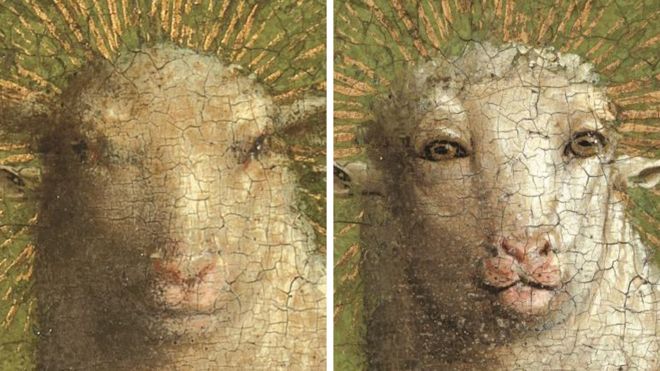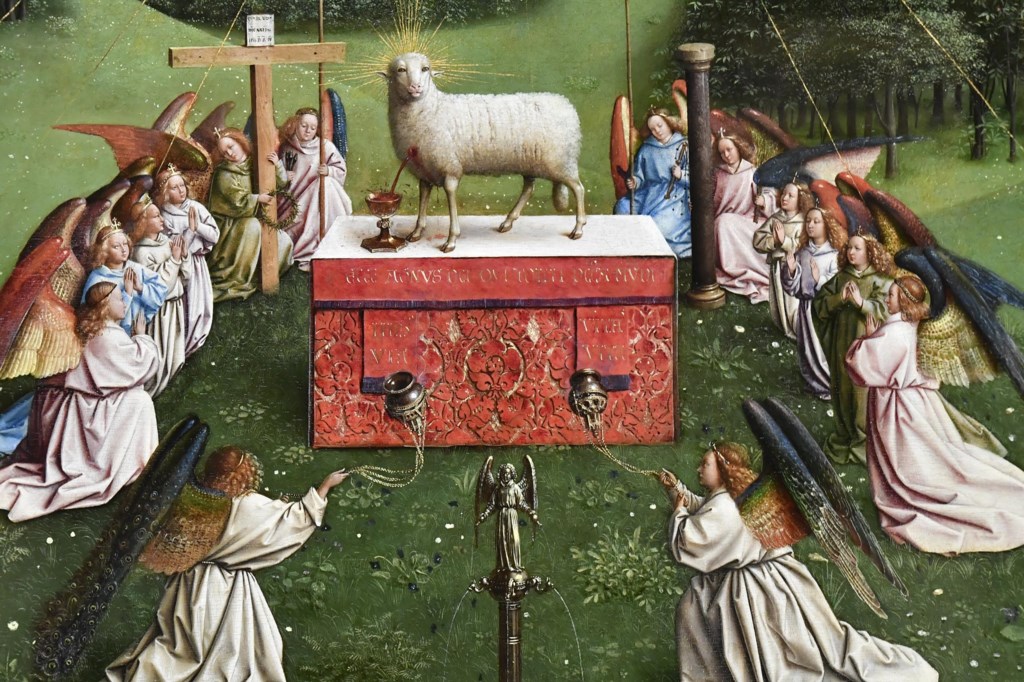Irrevocable mistakes were made during the restoration of the Ghent Altarpiece triptych by Jan van Eyck, and its central panel titled 'The Adoration of the Mystic Lamb,' two Van Eyck experts said, who are asking for the restoration to be stopped.
For years, restorers have worked on the triptych's central panel showing 'The Adoration of the Mystic Lamb'. However, emeritus professor of art history at KU Leuven and UCLouvain Hélène Verougstraete (specialising in technological laboratory research of paintings) and Jean-Pierre Coppens (a VRT reporter who has been studying the painting's history for 40 years) said that "downright disastrous" mistakes have been made: layers of paint have been poorly scraped away and have now irretrievably disappeared.
The artwork's history is important for its restoration: it is assumed that Hubert van Eyck started with the centre panel and provided the basic work. After his death in 1426, his more gifted brother Jan continued the work by making improvements and painting over fragments.
The painting therefore had two layers of paint from the start. Over the course of history, more layers have been added.
Removed palm branches and a hybrid lamb
Verougstraete and Coppens have now announced that several things went wrong during the restoration of the central panel.
During their work, the restorers of the Royal Institute for Cultural Heritage (KIK) scraped away various fragments with their scalpels. But according to the two experts, the restorers incorrectly assumed that the painting's top layer was a 16th-century overpaint.
The two critics believe that the top layer was by Jan van Eyck and find it unacceptable that it has now permanently disappeared.
This is clear, they said, in different areas of the painting, such as the holy women waving palm branches – about 20 of which were removed during the restoration. Some buildings in the background have also been scraped down to Hubert's unfinished version, resulting in the tracery on the church windows being lost.
Last year, the finished restoration also sparked some controversy about the lamb's head, which has been spectacularly changed. As only the upper layers on its head were removed, a hybrid lamb has now been created – Hubert painted the head and Jan the body.

Reactions to the restoration, on social media and in real life, describe the eyes of the Mystic Lamb as "shocking." Credit: The Royal Institute for Cultural Heritage
Additionally, at the top in the middle of the painting, a layer of the sky and the grass slopes was scraped away. However, the trees and shrubs were so detailed that they could only have been created by master painter Jan van Eyck, according to Verougstraete and Coppens. They are now gone forever. The restorers' "plentiful retouches" are, on the other hand, rather "shapeless," they lamented.
The experts also denounced that the restorers of the KIK did not follow the correct order: they started scraping off layers of paint and only then did they ask for an extra year of time for a thorough study. Verougstraete and Coppens believe that they should have informed the international committee of specialists prior to any intervention.
To prevent further damage, the pair are asking for the "immediate termination" of the third phase of the restoration.
Related News
- Now you can admire the Van Eyck’s Mystic Lamb in 100 billion pixels
- Ghent Altarpiece restoration reveals 'alarmingly humanoid' Lamb of God
- 2020 will be ‘the year of Van Eyck’ as restored Ghent Altarpiece goes on show
In a joint response, Flemish Culture Minister Jan Jambon and Immovable Heritage Minister Matthias Diependaele stated that their services had listened extensively to Verougstraete's concerns, which she brought to their attention in May.
A historical and scientific report was then drawn up. After extensive scientific research, it concluded that the KIK restorers only removed a 16th-century layer of paint on top of Van Eyck's work.
According to Jambon and Diependaele, this was done on the recommendation of the international committee consisting of 23 experts. They added that they find "no reason" to stop the current restoration.

